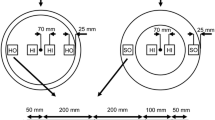Abstract
Supercritical fluid (SCF) impregnation is a promising preservative treatment method for wood. In order to commercialize the sub- and supercritical CO2 biocide treatment, better understanding of the fluid phase and its effect on treatment results have to be demonstrated and developed. Preservative treatability under super- and subcritical fluid conditions was evaluated using radiata pine sapwood, and treating characteristics in relation to different fluid phases and treatability were discussed. Various treatment conditions resulted in varying biocide retentions and distributions. Higher pressure conditions enhanced biocide retentions resulting from increasing biocide input in the applied saturation method. Subcritical CO2 condition produced higher biocide retentions and little retention gradients from face to core. Subcritical CO2 treatment has a couple of benefits such as investment costs and energy consumption compared with supercritical CO2.





Similar content being viewed by others
References
Acda MN (1995) Supercritical fluid impregnation of wood based composites. Ph.D. dissertation, Oregon State University. Corvallis, OR, p 160
Acda MN, Morrell JJ, Levien KL (2001) Supercritical fluid impregnation of selected wood species with tebuconazole. Wood Sci Technol 35:127–136
American Wood Preserver’s Association (2005) Standard methods for analysis of wood and solutions for propiconazole by HPLC. Standards A23. AWPA Book of Standards
Brubacher L (2006) Obtaining reliable data online-phase diagram for carbon dioxide. Chem 13 News 13
Chrastill J (1982) Solubility of solids and liquids in supercritical gases. J Phys Chem 86:3016–3021
Drescher M, Jokisch A, Korte H, Peek R-D, Steiner R (2006) Differential pressure characteristics of wood impregnated with compressed gases, liquids and supercritical fluids. Holz Roh-Werkst 64:178–182
Ehara K, Saka S (2005) Decomposition behavior of cellulose in supercritical water, subcritical water, and their combined treatments. J Wood Sci 52:148–153
Ginneken LV, Dutre D, Adriansens W, Weyten H (2003) Effect of liquid and supercritical carbon dioxide treatments on the leaching performance of a cement-stabilized waste form. J Supercrit Fluids 30:175–188
Hassan A, Levien KL, Morrell JJ (2001) Modeling phase behavior of multicomponent mixtures of wood preservatives in supercritical carbon dioxide with cosolvents. Fluid Phase Equilib 179:5–22
Itou NT, Someya T, Taniguchi M, Inamura H (1984) Japanese patent JP 59-101311
IUPAC (1976) CARBON DIOXIDE. International thermodynamic tables of the fluid state
Janssen’s product information sheet, n. d. Retrieved May 1, 2002. from http://www.janssenpharmaceutica.be/pmp/pages/database/$Evipol/$leaflets/PIS%20Evipol%20technical.pdf
Kang SM (2002) Supercritical fluid impregnation with biocides of wood using temperature reduction. Ph.D. dissertation, Oregon State University, Corvallis, OR
Kim GH, Kumar S, Sahle-Demessie E, Levien KL and Morrell JJ (1997) Bending properties of TCMTB-treated southern pine sapwood using supercritical carbon dioxide impregnation process. Int. Res. Group on Wood Pres. Doc. No. IRG/WP/97-40080. Stockholm, Sweden
Krukonis VJ (1988) Processing with supercritical fluids: overview and applications. ACS Symp Ser 366:27–43
Pruess K (2003) Numertical simulation of leakage from a geologic disposal reservoir for CO2, with transitions between super- and sub-critical conditions. In: Proceedings, TOUGH symposium
Sahle-Demessie E (1994) Deposition of chemicals in semi-porous solids using supercritical fluid carriers. Ph. D. dissertation, Oregon State University, Corvallis, OR, p 301
Sahle-Demessie E, Hassan A, Levien KL, Kumar S, Morrell JJ (1995a) Supercritical carbon dioxide treatment: effect on permeability of Douglas-fir heartwood. Wood Fiber Sci 27(3):296–300
Sahle-Demessie E, Levien KL, Morrell JJ (1995b) Impregnation of wood with biocides using supercritical fluid carriers. p 415–428 in K.W
Smith SM, Sahle-Demessie E, Morrell JJ, Levien KL, Ng H (1993a) Supercritical fluid (SCF) treatment: its effect on the bending strength of ponderosa pine sapwood. Wood Fiber Sci 25:119–123
Smith SM, Morrell JJ, Sahle-Demessie E and Levien KL (1993b) Supercritical fluid treatment: effects on bending strength of white spruce heartwood. Int. Res. Group on Wood Pres. Doc. No. IRG/WP/20008. Stockholm, Sweden, p 6
Sotelo JL, Calvo L, Perez-Velazquez A, Capilla D, Cavani F, Bolognini M (2006) A comparative study on the transalkylation of diisopropylbenzene with benzene over several zeolitic materials in supercritical CO2 and liquid phase. Appl Catal B 312(2006):194–201
Tsunoda K, Muin M (2003) Preservative treatment of wood-based composites with a mixture formulation of IPBC-silafluofen using supercritical carbon dioxide as carrier gas. International Research Group on Wood Preservation, Document No. IRG/WP/03-40251. Stockholm, Sweden, p 8
Yashiro M, Takahashi T (1996) The effects of high pressure on some mechanical and physical properties of wood. Prog Biotehnol 13:485–490
Author information
Authors and Affiliations
Corresponding author
Rights and permissions
About this article
Cite this article
Kang, SM., Cho, MW., Kim, KM. et al. Cyproconazole impregnation into wood using sub- and supercritical carbon dioxide. Wood Sci Technol 46, 643–656 (2012). https://doi.org/10.1007/s00226-011-0434-y
Received:
Published:
Issue Date:
DOI: https://doi.org/10.1007/s00226-011-0434-y




